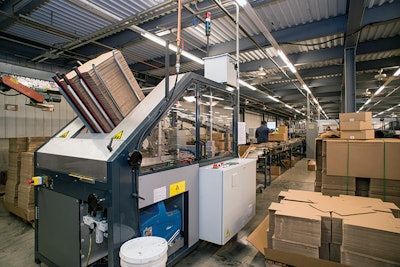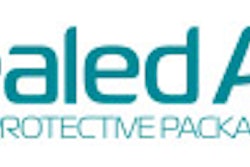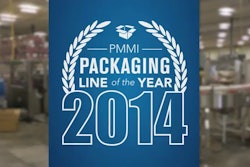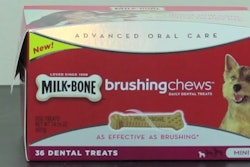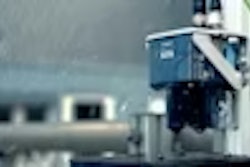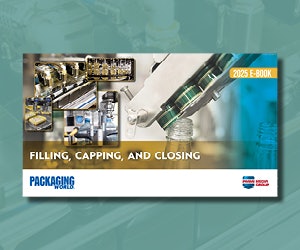MBS Textbook Exchange, Inc., Columbia, MO, is an industry leader in wholesale textbook distribution. Despite digital inroads, the traditional print textbook market remains solid across campuses nationwide, particularly for used books. MBS prides itself on providing its collegiate bookstore customers essential and simple business tools for successful new and used textbook marketing and was one of the first used-book wholesalers to offer direct on-line ordering for collegiate bookstores. On-line “out-the-door-in 24” purchases from stores and consumers now account for more than 90% of the company’s total order intake, according to Mark Pulliam, Vice President for Distribution for the MBS Textbook Exchange.
In addition to marketing innovations, MBS Textbook Exchange recognized the need to improve its packaging efficiencies and management of packaging operations costs. Protective packaging design improvements and more sophisticated automation technologies are key components that have helped MBS moved forward.
The company’s previous operational model featured four cold-seal machines with each system requiring up to four packaging personnel to operate. Individual staffers were assigned to scan books and boxes, move packages through available lanes, generate and apply invoices, and initiate cold-sealing of the corrugated shipping cases. These four lines produced an average of seven to eight packages per minute.
Pulliam says, “As our business expanded, it became evident that we needed to make changes to our packaging approach. Textbook ordering has historically been a last-minute process, and we could not afford to have our systems become overwhelmed any longer.”
While customers generally were receiving their orders within the promised time frame, packaging quality issues were being reported. Among these packaging quality problems to be addressed were imperfect product protection and non-user-friendly package opening systems. Complaints ranged from “clunky cardboard sandwiches that easily popped open during transport” to “difficulties in getting the packages opened at all.”
So, in 2009, MBS began exploring options for new automated systems capable of handling the company’s growing single-copy e-mail order volume. Pulliam recalls, “We kept our eyes open at every trade show we visited for a system that would help us improve our throughput, simplify our cold-seal process, reduce labor costs, and distribute a better-looking, more protective, more user-friendly package to our customers.”
Sealed Air Corp. learned of MBS’s interest in exploring automated packaging solutions for its mail order business. Lou Suffern, e-commerce Solutions Director for Sealed Air’s Product Care Division, noted, “Above all else, MBS Textbook Exchange’s fundamental need is ensuring that every package features the correct label and goes to the right place, well-sealed and undamaged. We immediately recognized that our I-Pack® solution could deliver these functionalities and implement them in a fairly seamless manner.”
Sealed Air’s I-Pack automated void-fill reduction system produces a smaller overall volume package that reduces freight costs. And the 100% recyclable corrugated materials can be sourced from local suppliers. In addition, the finished package with built-in opening tear strip enhances the package appearance and brand image.
By using the I-Pack system, MBS could implement more compact packaging around shipped items, eliminating the bulky, difficult-to-open format that customers disliked. The system produces tightly sealed packages for enhanced product protection with built-in tear strips for easy opening. In addition, the I-Pack system enables automation of every packaging step—from book scanning to placing in shipping cartons to printing and application of shipping labels. The label print/apply system that MBS and Sealed Air set up for the I-Pack was a Panther 2000 from Panther Industries, Inc.
MBS uses 100% curb-side recyclable corrugated board to ship its books. The Sealed Air I-Pack system is compatible with a variety of void-fill materials, including bubble wrap and crumpled wads of paper. But MBS has not found it necessary to use void-fill materials in its shipping cases. In this application, the I-Pack system electronically reads package contents and folds any extra corrugated to form a tight, compact package. The folded corrugated provides extra protection by holding the book(s) securely in place.
While the I-Pack system has enabled MBS to reduce the total number of tray/case sizes needed to ship orders, multiple pack configurations are still necessary to accommodate varying product dimensions. The thickness of the books being shipped dictates which tray/case will be used. Once the I-Pack identifies the package contents and measures the tray, it sets scoring parameters that enable folding at precise locations. The corrugated shipping package is automatically folded and glued shut. The system automatically applies a lid to the tray/case.
Following a brief testing period, MBS began implementing the I-Pack in early 2010. Installation took only a few days with Sealed Air’s service team working in tandem with MBS.
Book-keeping the benefits
The single I-Pack system at MBS is achieving a rate of 850 packages per hour, enabling the textbook distributor to significantly improve packaging efficiencies. Pulliam adds, “In terms of space, the single I-Pack machine occupies the same area in our processing plant as our four previous cold-seal machines did. Streamlining and consolidating packages to a single machine also helps get the deliveries out the door faster. We typically can operate the I-Pack system and shipping line with three employees, giving us a significant reduction in labor requirements.”
More specifically, package processing labor costs have been slashed by approximately 75%, due to the automation of invoice processing, label printing, and package sealing. And label configuration and production capabilities/flexibilities have been significantly improved.
Finally, says Pulliam, “The I-Pack has proven much easier for our employees to maneuver from several perspectives. Our team no longer has to reload heavy rolls of paper into packaging systems, and the physical demands of running and maintaining our old cold-seal machines is no longer an issue. When we started our partnership with Sealed Air, we were looking for a seamless, cost-friendly way to get the right book in the right box with the right label and get it to the right person intact. The Sealed Air I-Pack system has delivered.”
See a video of the I-Pack at pwgo.to/1257.
